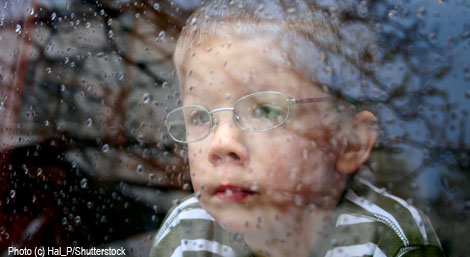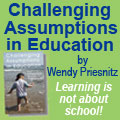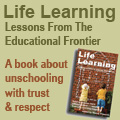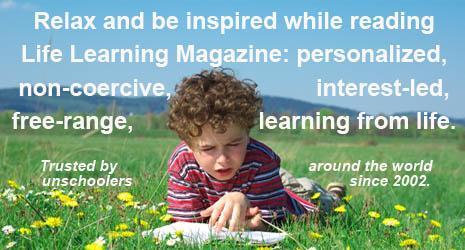|

Reflections on a Daydreamer
By Ellen Rowland
When my son was in kindergarten and I attended my first parent-teacher conference, I was told that he was a daydreamer and had trouble concentrating in class. “Not only is Jamie not in the same room with me, he’s not even in the same world,” his teacher had said. And although we both laughed, the remark was clearly tinged with concern, if not reproach, that Jamie could often be found staring out the window, pondering a leaf or the shape of a cloud, rather than paying attention to his ABCs. I knew what she meant. I had been frustrated myself having to call his name repeatedly to get his attention, only to have him look up at me like it was the first time he’d ever seen me.
But I also knew that he was a sensitive, intuitive, creative child who required lots of alone time as well as time spent in Nature. I knew that daydreaming was how he recharged his batteries, so to speak. And yet the seed had been planted. An authority figure had expressed concern about my son. And I began to wonder . . . was he a slacker in the making? Was his propensity for “drifting off” an early sign of a learning disability? I began to do some research.
The first thing I learned, to my relief, is that “positive-constructive daydreaming” is a perfectly normal activity in both adults and children and reflects imaginativeness and creativity. In fact, we now know through modern research that daydreaming is an important cognitive process that helps children process complex information, emotions, and events. So why the bad rap?
The origin of the negative aspects of daydreaming coincided with the Industrial Revolution when hand craft was replaced by the repetitive use of machinery tools. Because there was no room for creativity on the assembly line and precision was required, daydreaming on the job became associated with both laziness and danger and posed a threat to factory owners who wanted mindless drones to increase production. In the 1950s, daydreaming was associated with “self-indulging, grandiose fantasies,” and “wish fulfillment,” prompting a few educational psychologists to warn parents that daydreaming might lead their children into neurosis and psychosis.
Scientists and psychologists now understand the important symptomatic distinction between daydreaming and mental disorders such as schizophrenia. Psychologically healthy people who daydream are aware that they are in an altered mental state and can snap out of it at will or when distracted by external stimuli, whereas individuals who experience hallucinations are unable to distinguish between their delusions and reality. The “positive-constructive” distinction is made in opposition to individuals, including children, who rely on a heavy pattern of daydreaming as an escape from low self-esteem or more serious situations such as emotional or physical abuse. As the burden of observation and awareness of children’s learning and well-being is often placed on teachers, daydreaming is linked to the inability to concentrate and therefore tends to signal a “problem.”
Daydreaming and Learning
Albert Einstein, among other great thinkers and scientists, was a documented daydreamer in the classroom. In fact, he was expelled from school (although he had already decided to drop out) because he began to rebel against prescriptive learning, choosing instead to pursue his own ideas. It is widely believed that Einstein’s Theory of Relativity was born from daydreaming about running alongside a sunbeam to the edge of the universe. Now let’s imagine if he had gone to school today, been diagnosed with Attention Deficit Disorder (ADD), and put on Ritalin. The world would indeed be a different place.
Despite modern research on the positive aspects of daydreaming, school remains a results-driven place where teachers and even parents are too quick to label it a sign of laziness at best and, at worst, a symptom of ADD. Children who attend school tend to have highly structured days, even at an early age. Standard curriculum dictates that a child learn rote information at specific ages and on a tight schedule. Thus, the inability to sustain attention to the task at hand is often considered poor self-control, a problem that needs to be fixed, often with medication. And while that medication may indeed enhance children’s ability to focus, it suppresses other brain functions, dulling children’s imagination and their ability to problem-solve creatively.
In a classroom environment, many children stare into space or look away from their teacher for periods of time while being taught. Referred to as “gaze aversion,” this reflex, rather than indicating disinterest, relates to the complexity of the information or task. If the child finds the material difficult or unfamiliar, in addition to trying to interpret the teacher’s visual cues and shut out any other distractions, his brain will signal an overload. Looking away and “resting” the brain actually helps the child process information. Interestingly, scientists now know that daydreaming is the default mode of the mind. In this state, the brain is not idle, as was once thought, but is capable of multi-tasking. In other words, a child who appears to be “zoned out” is usually able to engage in imaginative thoughts and absorb external information at the same time.
Dr. Jerome L. Singer, along with his wife Dorothy G. Singer, pioneered research into the positive aspects of daydreaming in the 1960s. He wrote: “We have found that many children who are creative and imaginative may find that they can avoid some of the boredom or repetition of ordinary classroom work by drifting into playful fantasies without missing the material being presented.”
Singer also points out that before children reach school age, they are encouraged to verbalize their thoughts in order to enhance language and vocabulary skills. But once they are in the classroom, they become conditioned to do the opposite – to be quiet and listen – another reason children enter the private world of daydreaming while in class.
Daydreaming and Creativity
Researchers have found that children who are given quiet time to daydream, to engage in make-believe, and invent imaginary friends are highly creative in their story-telling and artwork, tend to have advanced language and social skills, and are actually more focused and happy during play. In contrast, children who are allowed to fill up their down time watching TV tend to have a lower threshold for focused play. (It is estimated that the average child spends eighty percent of her free time in front of the television.)
The theory is simple: two children are playing with blocks. The child who regularly engages in imaginary conversations, scenarios, and role-playing is capable of weaving a narrative into his block construction that sustains his attention. However, the child who has not developed her daydreaming “skills” may only see pieces of square wood and easily get bored. So in this example, we see that daydreaming does not in fact foster a lack of attention, but is a means of arriving at a more creative and ultimately more interesting approach to play.
As Dr. Singer states: “Daydreaming is important because it is a critical way in which human beings move beyond their immediate environment to create vicarious virtual realities that allow them to try out alternative personalities and interests.”
After completing his research, Singer advocated that school teachers and parents give their children adequate time for reflection, unstructured thinking, and daydreaming as a means of helping them process complex emotions and information and promoting creativity. And his enduring advice has extended beyond children and into the adult workplace. Many open-minded CEOs of innovative companies like 3M and Google have used daydreaming to their advantage by prioritizing individuality and creativity. Google’s work rule “twenty percent time” allots employees one day a week to spend on “projects that aren’t necessarily in [their] job descriptions.” Gmail, Google News, and Google Talk are among just a few of the tools created by employees during twenty percent time.
Daydreaming and Life
For a variety of reasons, my husband and I decided five months ago to take Jamie and his younger sister, ages six and seven, out of school and embrace life learning, a decision that was natural for my husband who is largely self-taught, and fraught with insecurity for me, having gone from pre-school through graduate school within the “system.” Interestingly, this decision coincided with the end of my delve into daydreaming. I had felt compelled as a parent to research the subject as a means of understanding the process and what it meant to my son’s educational and personal development. And I learned a great deal in the process. But in the end, I reached a conclusion that I had already made, instinctively and deep down inside: My son’s daydreaming is not a problem, but a joyful facet of his personality. The facts were interesting and instructive, but the lesson was invaluable. I could trust myself. I could trust my son. This realization was my first affirmation of learning through living! And here I thought this decision had been about my kids.
Admittedly, the sudden lack of structure in the beginning was not without confusion, tears, and less than ideal behavior – and that was just my reaction! But eventually, we each found our path. Within the first few weeks of life without school, Jamie demonstrated that he could focus endlessly on activities like building LEGO factories and drawing the flags of the world, which he learned from the side index of our world map. He began to express an interest in geography, aviation, architecture, cooking – all subjects that were not included in his school curriculum of lower-case, upper-case, script, cursive, add, subtract, and repeat. In school, he was having trouble with reading and writing and yet he clearly labeled each of his flag drawings with its corresponding country. He asked my husband, who is an architectural designer, if he could sit in on client meetings and now he draws detailed plans of houses, boats, and airplanes. He and his sister make up elaborate travel adventures that they act out for us. My daughter sews the costumes. She wants to learn Italian and Arabic and play the violin, but she’s another story altogether.
Most importantly, our children have lots and lots of down time to reflect, explore, and dream. Staring out the window still holds a great deal of attraction for Jamie. Only now, it’s wide open.
Learn More
Imagery and Daydream Methods in Psychotherapy (Personality & Psycho-pathology Monographs) by Jerome L. Singer (Academic Press, 1974)
The House of Make-Believe: Children’s Play and the Developing Imagination by Dorothy G. Singer and Jerome L. Singer (Harvard University Press, 1992)
Daydreaming: An Introduction to the Experimental Study of Inner Experience by Jerome L. Singer (Random House, 1966)
Daydreams at Work: Wake Up Your Creative Powers by Amy R. Fries (Capital Books, 2009)
Ellen Rowland is an American living in Senegal, W. Africa in an off-the-grid earth house she helped build with her husband and two home-schooled children. She is a writer of sustainable issues, fiction, humor, and poetry and is currently working on a book about her experiences with life learning. She has also contributed articles to Natural Life Magazine and is a nascent life learner. This article was published in Life Learning Magazine in 2012. Read more of her work on her blog.
Copyright © Life Media
Privacy Policy
  
  

|

